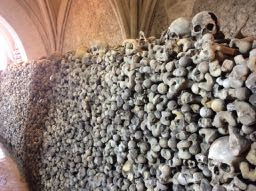We visited the seaside at Hythe in Kent, one of the five Cinque ports, on Saturday. Hythe is a pleasant little market town, although nothing like as pretty as Rye or Winchelsea.
The highlight of Hythe for medievalists is found beneath St Leonard’s Church. The church itself is an enormous edifice up on the hill, largely built in the fourteenth century, with features going back to the eleventh century. That is all quite typical of an old Kentish church, and luckily St Leonard’s has been left relatively unscathed by the dreaded Victorian Church Restorers.
Under the chancel, there is a long-forgotten chamber that holds a remarkable collection of medieval bones. Over a thousand skulls are neatly arrayed in racks and there is a huge neat stack of bones. Local legend claims that these are victims of the Battle of Hastings, but analysis has revealed the majority are women, and there are few wounds in evidence. The crypt’s attendant had a much more prosaic explanation for where the bones came from: when the chancel was built in the fourteenth century, much of the churchyard was dug up. The bones of parishioners found during the building work were stored in the cellar of the church and forgotten about for centuries. The earliest references to the ossuary date from the seventeenth century and the current layout, with its neat stack of bones, was assembled in 1910. The collection has recently yielded interesting information on the health of medieval people, which wasn’t great.
The crypt is not as spooky as an old room housing thousands of human bones might be. There are large windows providing plenty of natural light and the skulls seem content to mind their own business as we tourists passed through. But I found that if I stopped to examine the bones more closely they ceased to be gothic decor and became the remains of individuals. Once, these grey and decaying relics were people who were in the centre of their own universes, just like I am in mine. The owners of some of these skulls knew and maybe loved the owners of others. Now every one of them is anonymous and unknown. The dead are democrats as they all now count for the same.
While ossuaries are not uncommon on the Continent, there is nothing else quite like the St Leonard’s crypt in England. It is generally open over the summer and well worth a visit.
Discuss this post at the Quodlibeta Forum
Tweet



"Mount thou upon the ruined mounds of ancient
ReplyDeletecities and walk around;
behold the skulls of those of earlier and late times.
Who is the evildoer, who is the benefactor?"
The Dialogue of Pessimism- ca. 1,000 B.C.
St Leonard’s crypt is a fascinating glimpse into medieval burial practices, especially with its large collection of human bones—Europe’s largest known ossuary. For those exploring historical or cultural studies, resources like NURS FPX 4010 Assessment 3 offer structured learning to deepen your understanding. It's incredible how sites like this bridge the gap between historical intrigue and modern education.
DeleteThere is definately a great deal too find out about this topic.
ReplyDeleteI love all of the points you have made.
ReplyDeleteVery informative and well-written post! Greatjob for your hardwork man!
ReplyDeleteI am appreciative of the fact that you have shared this knowledge with us.
ReplyDeleteEfficiently written information.. Keep up the good work.
ReplyDeleteDefinitely a good blog is very good. Thank you for sharing.
ReplyDeleteHello There. I found your blog using msn. This is a really well written article.
ReplyDeleteI love reading this site. This was really very informative site for me.
ReplyDeleteThank you for posting such a great article!
ReplyDeleteGOOD AFTERNOON! I WISH, YOU ALWAYS POST MORE BLOG LIKE THIS!! THANK YOU
ReplyDeleteA GREAT BLOG. I WILL DEFENITELY BACK.
ReplyDeleteI WAS IMPRESSED BY THE GOOD WRITING.THANK YOU
ReplyDeleteI really like your blog.. very nice colors & theme.
ReplyDeleteThis is really helpful post and very informative there is no doubt about it.
ReplyDeleteIt’s exceptionally useful and you are clearly extremely proficient around there.
ReplyDeleteAwesome and entertaining article. I like to write a little comment to support you.
ReplyDeleteYou have the most beautiful layouts i was quite grateful.
ReplyDeleteI'll continue to read your blog.Excellent blog.
ReplyDeleteAmazing. You consistently inspire me. New posts usually have an impact on your blog!
ReplyDeleteContinue publishing such fascinating articles; your visitors will grow to like your writing.
ReplyDeleteFound this interesting post to read. I really enjoy it!! Pretty great article
ReplyDeleteWonderful job. I really enjoyed this blog of yours, Too cool to have like this
ReplyDeleteHey pretty!! Thanks for posting, You have great blog here. keep it up..
ReplyDelete